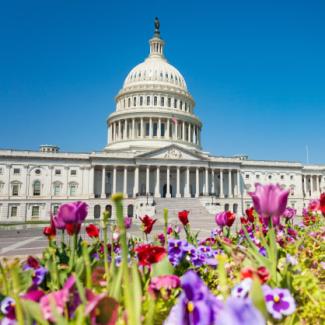
SECURE Act 2.0—a Rundown of the Most Important Aspects
The Senate has just passed another bill to be folded into SECURE Act 2.0 before both chambers vote on the full package. Here Jeff Levine takes a close look at the main body of SECURE Act 2.0 and its primary proposed changes for the world of retirement planning.
Editor’s note: Catching you up on where we are with SECURE Act 2.0: In May 2021, the House Ways and Means Committee cleared a new bill, Securing a Strong Retirement Act of 2021—aka SECURE Act 2.0. With its strong bipartisan support, many industry watchers predicted it would pass into law in 2021. But as often happens, other issues took priority.
In 2022, SECURE Act 2.0 was again brought up in the House, and on March 29, it passed this chamber almost unanimously (414-5) and went to the Senate. In June, the Senate passed bills from its HELP Committee and Finance Committee (the EARN Act and the Rise & Shine Act ). These will be combined to make up the Senate’s SECURE Act 2.0 package, probably before July 4th. Once reconciled with the House-passed SECURE Act 2.0 legislation, the final bill will be voted on by both chambers.
Here we present Jeff Levine’s overview of the main body of SECURE Act 2.0 as it initially was presented to the House.
SECURE Act 2.0 clocked in at 146 pages. While that pales in comparison to other recent legislative endeavors, it’s worth a reminder that this is 100% retirement stuff! So, there’s actually a ton to digest here for planners. Certainly, more than we got from CAA. Maybe even more, in total, than we got from the original SECURE Act (though no one provision will have the impact that the “death of the stretch” had).
Do I think this is going to pass? Yes. And while I’d be surprised if there weren’t some changes, I’d be more surprised if it died altogether. It has strong bipartisan support and politicians love talking about how it saved your retirement. I’d say 90% it gets passed in similar form.
Changes to RMDs
Let’s begin with RMDs, because they basically impact all non-Roth IRA retirement account owners. RMDs gradually get pushed back from age 72 (current) to age 75. Yep. Instead of just making it 75 and having it be simple, Congress be Congressing…
RMDs would start at:
- 73 if you turn 72 from 2022‐2027
- 74 if you turn 72 in 2028‐2029
- 75 if you turn 72 in 2030 or later
I want to jump to something else in the bill now because I think it is sneaky important.
Right now, taxpayers generally have no statue of limitations for IRA penalties. So, theoretically, you miss an RMD today, and the IRS can come back in 20 years and assess the penalty, interest, and so forth.
Without boring you to death, the reason is because those penalties get reported on Form 5329. IRS and the Tax Court have previously agreed Form 5329 is its own return. So, if you don’t file Form 5329, there is no start of clock for statute of limitations. No one just randomly files Form 5329, so unless you knew you had a penalty and filed, you were basically leaving yourself open to IRS scrutiny forever.
This would solve that by saying if you filed your income tax return (Form 1040), that starts the clock. It even goes so far as to say that if you didn’t file a return because you didn’t have to, the statute of limitations starts when you otherwise would have filed your return (if you needed to).
Pretty taxpayer-friendly, and frankly, maybe my favorite thing in the whole bill.
Catch-up contributions
Section 106 would finally index IRA catch-up contributions for inflation.
Presently, the IRA contribution, plan salary deferral, plan catch-up contribution, and plan overall limits are all indexed for inflation…but not the IRA catch-up contribution limit. It has to be increased by legislation, and that’s only happened one time…for 2006!
Section 107 creates new plan catch-up contribution limits in years a participant turns 62, 63 and 64.
Such (62- to 64-year-old) participants would have following catch-up contribution limits beginning in 2023:
- 401(k)s and similar plans: $10k ($6.5k today)
- SIMPLE: $5k ($3k today)
On the surface this is cool, but for the life of me, I can’t understand why Congress is so interested in helping 62- to 64-year-olds save for retirement, but not 65-year-olds. They go out of their way to ensure you that at 65, you can take a hike.
Thought we were done talking about catch-up contributions, huh? Well, guess what? Fooled you!
Section 603 would require all catch-up contributions to be made to Roth accounts!
I have a lot to say about this. First, not all plans have Roth options yet. What happens to those participants?
Notably, this would take effect in 2022! That’s not all that much time with everything else businesses have going on these days.
Second, for those who continue to question whether Uncle Sam will keep the Roth IRA around or whether it will be eliminated because it’s “too good”…
Let this be the latest evidence of what I’ve been saying for years, Uncle Sam loves the Roth.
It brings in money today, and people like it. Name me anything else that does that.
SEP and SIMPLE Roth accounts
In another “pay-for” provision, Section 601 of SECURE Act 2.0 would create SEP and SIMPLE Roth accounts, and Section 604 would allow individuals to designate employer matching contributions to the Roth side. Best I can tell, Roth SIMPLE IRA salary deferrals would work similarly to Roth 401k contributions.
As for SEP or matching contributions, I think they would just get added to the W-2 somehow.
QLAC rules
On to the portion of this bill that was likely written by the Life Insurance lobbyists…don’t kid yourself, they are a very powerful group.
Section 202 would amend the QLAC rules to eliminate the 25% limit (of account balance) on purchases. It appears to keep the current overall limit of $135k (indexed) in place. So, essentially, someone would be able to use all retirement account dollars, up to $135k, to purchase a QLAC.
It also would clarify the treatment of contracts in the event of a divorce and allow up to a 90-day free look.
Section 203 would expand investment options for insurance contracts. Specifically (but still subject to some limitations), insurance contracts would be able to incorporate ETFs into their offering.
So, in the near future, we might see VUL and/or VA policies with ETF options. Coupled with potential changes to the capital gains rules (e.g., the top rate and changes to the step-up), low-cost ETFs inside a low-cost VA wrapper could become a particularly attractive option for some high-income taxpayers.
Lastly on the insurance front, more flexibility would be given to income annuities in retirement accounts. Such contracts could have:
- Up to a 5% annual COLA on payments
- Lump-sum payments that reduce or eliminate future payments
- Dividends (based on experience)
- ROP less premium death benefits
- Payments up to 12 months in the future paid now
- Previously, these benefits often would have caused the annuity to run afoul of various actuarial requirements.
QCD rules
Significant changes to QCD rules could be on the way! Section 309 would:
- Index the $100k limit for inflation
- Allow a one-time, up to $50k QCD to a split-interest entity (e.g., CRAT, CRUT, charitable gift annuity) solely funded via QCD
Last part kills it, at least for CRUTs and CRATs. The cost to establish (e.g., drafting) and maintain (e.g., annual tax returns) a CRUT/CRAT is likely not worth it if you can only fund it with $50k (or maybe $100k for couples). Plus, all distributions will be ordinary income.
RMD penalties
The 50% penalty for missing an RMD would be reduced to 25% under Section 302 of the bill.
The 25% amount would be further reduced to 10% for errors timely and appropriately corrected within the “correction window,” which could be as long as three years. Sounds great, but right now, if you realize you missed an RMD but take corrective action and properly request relief you’ll likely get a waiver of the 50% penalty.
But I wonder if the IRS will become stingier with “only” a 10% penalty.
Prohibited transactions
Sticking with the theme of making IRA mistakes less painful: Section 321 would amend the IRA Prohibited Transactions (PT) rules (a.k.a. “things you can’t do with your IRA”), curtailing what is, today, one of the most punitive penalties around.
Presently, committing a PT with just $1 of IRA funds results in the deemed distribution of the entire IRA account in which the PT occurs.
For example, a PT with $100 in a $500k IRA and your $500k is deemed distributed. Immediate taxation, plus the 10% penalty for those under 59½.
Under SECURE Act 2.0, the penalty would change so that only the amount involved in the PT would be deemed distributed.
That seems like a punishment more in line with the “crime” (and is already how prohibited investments are dealt with).
Qualified student loan payments
Section 109 would codify what we’ve seen in recent Private Letter Rulings.
Employers would be able to make “matching contributions” to a 401(k), 403(b) or SIMPLE IRA to the extent the participant made what would technically be known as a “Qualified Student Loan Payment.”
Other provisions
- Section 320 would allow sole proprietors (only) to make retroactive first year (only) deferrals up to filing deadline (no extension).
- Section 315 answers a question we’ve had since the original SECURE Act was passed. Qualified Birth and Adoption (QBAD) distribution can be repaid for up to three years.
- Section 316 would allow more hardship distributions based on employee self-certification (this is how it worked for coronavirus-related distributions, and that seemed to work fairly well).
- Section 317 would create a new 10% penalty exception for victims of domestic abuse. It would allow impacted individuals to take up to the lesser of (1) 50% of their account balance or (2) $10,000 without the 10% penalty. Such individuals would also be able to pay back (rollover) the distribution for up to three years.
- Currently, public safety employees can access plan money without a 10% penalty if they separate in the year they turn 50 or later. Section 310 would expand this relief to private-sector firefighters.
- SECURE Act (original) made part-time employees mandatorily eligible for 401(k) participation once they had three or more consecutive years of 500+ hours (counting years in 2021+). Section 114 reduces it to ‘just’ two years. So, more part-time workers will have plan access sooner!
- Section 104 would expand 403(b) investment options to include certain Collective Investment Trusts (CITs).
- Section 101 says to be considered a 401(k)/403(b), unless a participant opts out, the plan must auto-enroll them for first-year contributions of between 3% and 10% of compensation, and that percentage MUST increase by 1% annually until it gets to between 10% and 15% (with some exceptions until 2025). Auto-enrollment has a huge impact on retirement savings. So making it mandatory for plans makes sense. But here’s a list of plans exempt from the requirement:
- SIMPLE plans
- Any existing 401(k)/403(b)
- Business less than 3 years old
- Business has less than 10 employees li>
- Section 306 creates the “Retirement Savings Lost and Found” to help participants track down lost retirement money, and the “Office of the Retirement Savings Lost and Found” (seriously!) to manage it.
There’s actually more in the bill, but that’s pretty much all the big stuff, and then some. Chances are it will pass. And when it does, it’s probably going to look a lot like this.

